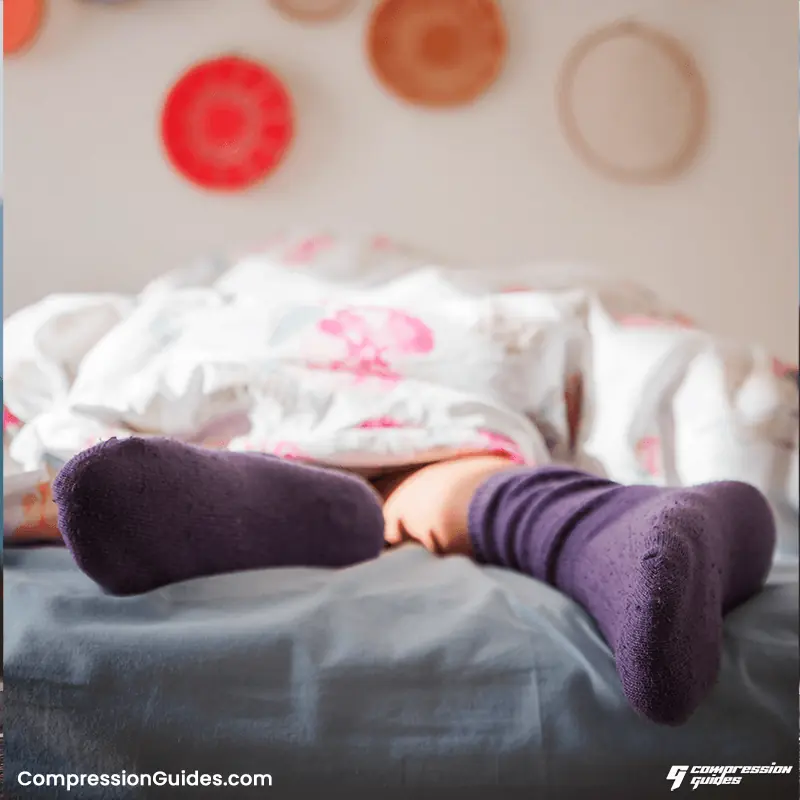Compression socks are a type of medical hosiery that is designed to help improve circulation and reduce swelling in the legs. But if you are wondering if it is safe to sleep in compression socks or if there are any benefits to wearing them to bed or not, Let’s find out!
Is It Safe To Wear Compression Socks To Bed?

In general, sleeping in compression socks is generally safe as long as you properly fit and find them comfortable. However, it is not recommended to wear them to bed as they may cause discomfort and make it difficult to move around in bed.
In some cases, you may consider wearing compression socks at night if you have a condition such as venous insufficiency or chronic venous hypertension, which can cause swelling in the legs and feet.
In these cases, it is better to consult with a doctor, who will likely provide specific instructions for wearing compression socks at night.
Read: How To Wear Compression Socks
Are There Any Benefits Of Wearing Compression Socks To Sleep?
According to experts, wearing compression socks while sleeping has no benefit because the legs are stationary and not subject to gravitational forces. This means that blood flow is not affected in the same way that it is during the day when the legs are moving.
This also means that the potential benefits of wearing compression socks, such as improved circulation and reduced swelling, may not be present while sleeping.
So, it is best to wear compression socks when you are active during the day instead of night in bed. That’s because the gentle squeezing action happens when your legs and body are actively moving during the day.
Read: Benefits of Compression Socks
Risks of sleeping with compression socks
There are several disadvantages to sleeping in compression socks:
What Else Can You Do Instead Of Wearing Compression Socks To Bed?
If you are experiencing swelling or discomfort in your legs or feet at night, there are several ways you can try to improve blood circulation:
Leg elevation
Elevating your legs above the level of your heart can be a simple and effective way to improve circulation and reduce swelling.
When your legs are elevated, gravity helps to push blood and fluid away from your lower legs and back towards your heart, which can help to reduce swelling and fatigue.
You can use a pillow or wedge to prop your legs up while you sleep, or you can use a special leg elevation pillow designed specifically for this purpose.
Loose-fitting pajamas or nightgowns
Wearing loose-fitting clothing can be a simple and effective way to improve circulation and reduce swelling & fatigue.
Tight or constricting clothing, such as tight jeans or leggings, can restrict blood flow and cause swelling in the legs and ankles. Wearing loose-fitting clothing can help to reduce this constriction and improve circulation.
Loose-fitting clothing can also be more comfortable to wear, especially if you are experiencing swelling or discomfort in your legs or feet.
Some people find that wearing loose-fitting clothing made of natural, breathable fabrics, such as cotton or linen, is especially comfortable and can help to improve circulation.
Massage
Massaging your legs and feet before bedtime can be a simple and effective way to improve circulation and reduce swelling and can help to stimulate blood flow and promote relaxation. Massaging can also help to improve muscle tone and flexibility, which can reduce stiffness and discomfort.
There are several ways you can massage, including using your hands, massage oil or lotion, or a handheld massager. Some people find that using massage oil or lotion can help to make the massage more comfortable and relaxing, while others prefer to use a handheld massager to target specific areas of the legs and feet.
Massaging before bedtime can be a relaxing and enjoyable way to improve circulation and reduce swelling, and it may also help to improve sleep quality.
Exercise
Engaging in regular physical activity, such as walking or stretching, can be an effective way to improve circulation and reduce swelling.
Regular physical activity helps to stimulate blood flow and promote the movement of fluids through the body, which can help to reduce swelling and fatigue and improve muscle tone and flexibility, which can help to reduce stiffness and discomfort.
Walking is a simple and accessible form of physical activity that can be done by people of all ages and fitness levels, and it can help to improve blood circulation. Stretching can also be beneficial, as it helps to increase flexibility and improve muscle tone.
Conclusion
Because compression socks have no benefit while sleeping unless you have a serious condition. You can also try other methods to improve leg circulation.
However, it is important to speak with your healthcare provider if you are experiencing swelling or discomfort in your legs or feet while sleeping, as there may be an underlying medical condition that needs to be addressed.
Your healthcare provider can help you determine the most appropriate treatment for your symptoms.
Read: Ultimate Buying Guide For Compression Socks


